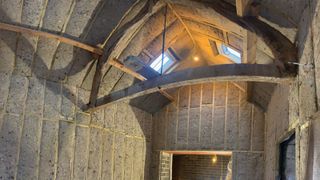Sheep wool insulation: How good is this eco-friendly option?
Is sheep wool insulation is just a woolly idea or has it got legs as a good insulator? Sustainable building expert, Tim Pullen, takes a look

You may well have read about sheep wool insulation but have you considered it as an option for your home?
If you want to reduce your carbon footprint then looking athow to insulate your house是一个很好的起点。但是如果你决定you want to reduce your carbon footprint further still and opt for a sustainable, natural, plentiful material, then sheep wool insulation ticks all the boxes.
Unlike many other natural materials used for insulation — which range from wood fibre and corkboards to flax and cotton – wool is a naturally recurring product. As we all know, sheep need shearing, and that produces the wool. Trees do not have to be felled for wood fibre and fields can be used to grow food instead of hemp.
What is sheep wool insulation?
Wool is, well… wool. Being a fibrous material it has a natural insulation capability. Sheep provide wool in a variety of colours, literally from black to white. Bales of wool arriving at the manufacturing plant are therefore mixed to provide a consistent colour that suits what the manufacturer wants. It is then washed (repeatedly) to remove dirt – what is euphemistically called “vegetable matter” and lanolin. The clean wool is then treated with either borax – an organic compound – or ‘ionic protection’, which is a patented plasma ion treatment. Both produce a material that is impervious to insect or vermin attack, one with a naturally occurring organic compound and the other by that patented process. In reality there is no reason to base a judgement on either method. They both do what they say they will.
The wool is then carded, which is the mechanical process of brushing, to disentangle the wool and get all the fibres lying in the same direction. This then produces a thin layer of insulation that is bonded to more layers to produce the desired thickness of insulation. At this stage some manufacturers introduce recycled polyester fibre to improve the stability and rigidity of the wool. Others use a mechanical bonding process that achieves the same thing. And others keep it simple and stick to 100% wool.
This whole process uses only 15% of the energy needed to make fibreglass or rigid foam insulation. With 100% wool products, that figure drops below 10% of the energy required. Another benefit of thisnatural insulationis that the process doesn’t need any nasty chemicals and produces a product that is biodegradable at the end of its life.

Is sheep wool insulation fire resistant?
As no unpleasant chemicals were introduced during manufacture then no chemicals, like formaldehyde, will be given off. The borax or ionic protection used during manufacturing ensures that the material remains impervious to insect, rodent or fungal attack.
Wool is naturally resistant to fire as it will only smoulder or char rather than actually burn — it will not fuel a fire. Sheep wool, like all insulating materials, must pass fire tests to ensure it is fit for purpose.
Products are tested to Euro Class C or British Standards BS 476 or BS 5803 to ensure their fire resistance.
Where can I use sheep wool insulation?
Sheep wool insulation is available as either semi-rigid slabs (also called batts) or as soft rolls. So the only place it is not ideal is when insulating the solid ground floor. It doesn’t handle compression well.
The stability that is introduced during the manufacturing process means it does not slump or sag so it can be used vertically as well as horizontally, which makes it suitable forinsulating suspended floors, walls and roofs. It also naturally maintains its dimensions. It does not shrink over time and can be cut with scissors or a knife. It is recommended that it be cut slightly larger than the gap between the timbers that surround it to provide a snug fit. A couple of tacks to ensure it does not move and it will stay there for the life of the building.

How much does sheep wool insulation cost?
Sheep wool is more expensive than mineral wool, fibreglass or foam insulation, but cheaper than spray foam. The 100% wool product is likely to cost £25/m at 100mm thick while the polyester mix product will be around £18/m.
This compares to around £13/m for mineral wool or fibreglass. Polyisocyanurate (rigid foam) insulation is a better insulator than any of the wool materials and an equivalent thickness would cost around £9/m.
价格区别polyester-mix羊wool and mineral wool is probably not a deal breaker (within the overall build cost) but if price is the determining issue then rigid foam insulation will win. Especially as more sheep wool is needed to achieve the sameU value.
What is the K value of sheep wool insulation?
The K value is a measure of the materials’ ability to conduct heat, so the lower the figure the better. For sheep wool it is around 0.038W/mK, which is about the same as mineral wool but not as good as PIR at 0.022W/mK.
This means that you need a 40% thicker layer of sheep wool to achieve the same level of insulation as PIR. Or, 100mm sheep wool = 70mm PIR.

What are the advantages of sheep wool insulation?
In a way, there are all the benefits that you might expect: a natural, renewable, sustainable material with very low embodied energy and devoid of chemical additives.
It is also really good for those after an insulation withsoundproofing and noise controlproperties. But there are a couple of other less well-known features that are equally important.
Sheep wool is hygroscopic, meaning that it is able to absorb moisture from air, and release it again, making it a “breathable” material. It is able to absorb 30% of its own weight in moisture without affecting its thermal performance – a handy feature in the UK’s damp climate – but it also has a more direct effect on the timber that surrounds it.
Sheep wool will tend to draw moisture away from the timbers, helping to protect them from dry rot. This ability to absorb moisture in damp conditions and release it again when the air temperature is warmer and drier also helps maintain a more stable internal temperature.
Sheep wool also has the highest specific heat capacity of comparable materials. That means it can absorb more heat than other materials. This slows the movement of heat inside to outside, but also outside to inside, keeping the house cooler in summer. All the insulators do this, but sheep wool does it very well.
Given all these benefits and that its only downside is cost then it could be deduced that if it were price comparable it would take over the market. And if your goal is reducing your carbon footprint, then look no further

Tim is an expert in sustainable building methods and energy efficiency in residential homes and writes on the subject for magazines and national newspapers. He is the author ofThe Sustainable Building Bible,Simply Sustainable Homes and Anaerobic Digestion - Making Biogas - Making Energy: The Earthscan Expert Guide.
His interest in renewable energy and sustainability was first inspired by visits to the Royal Festival Hall heat pump and the Edmonton heat-from-waste projects. In 1979
这最初的热情爆发导致他试着g (and failing) to build a biogas digester to convert pig manure into fuel, at a Kent oast-house, his first conversion project.
Moving in 2002 to a small-holding in South Wales, providing as it did access to a wider range of natural resources, fanned his enthusiasm for sustainability. He went on to install renewable technology at the property, including biomass boiler and wind turbine.
He formally ran energy efficiency consultancy WeatherWorks and was a speaker and expert at the Homebuilding & Renovating Shows across the country.
Get the Homebuilding & Renovating Newsletter
Bring your dream home to life with expert advice, how-to guides and design inspiration, direct to your inbox.
Tim is an expert in sustainable building methods and energy efficiency in residential homes and writes on the subject for magazines and national newspapers. He is the author ofThe Sustainable Building Bible,Simply Sustainable Homes and Anaerobic Digestion - Making Biogas - Making Energy: The Earthscan Expert Guide.
His interest in renewable energy and sustainability was first inspired by visits to the Royal Festival Hall heat pump and the Edmonton heat-from-waste projects. In 1979
这最初的热情爆发导致他试着g (and failing) to build a biogas digester to convert pig manure into fuel, at a Kent oast-house, his first conversion project.
Moving in 2002 to a small-holding in South Wales, providing as it did access to a wider range of natural resources, fanned his enthusiasm for sustainability. He went on to install renewable technology at the property, including biomass boiler and wind turbine.
He formally ran energy efficiency consultancy WeatherWorks and was a speaker and expert at the Homebuilding & Renovating Shows across the country.
Most Popular
Bring your dream home to life with expert advice, how-to guides and design inspiration, direct to your inbox.
Thank you for signing up to Homebuilding. You will receive a verification email shortly.
There was a problem. Please refresh the page and try again.
